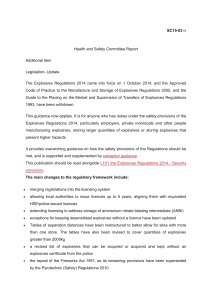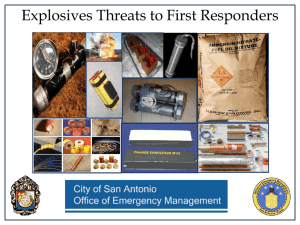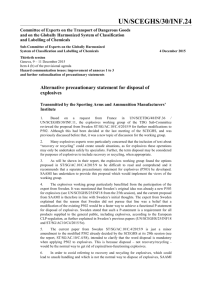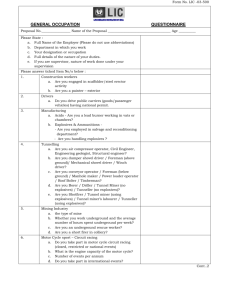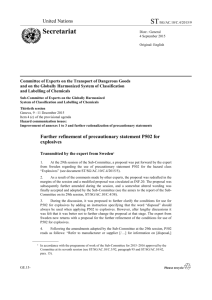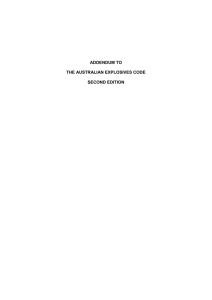Class 1 explosives * Dangerous goods transport
advertisement
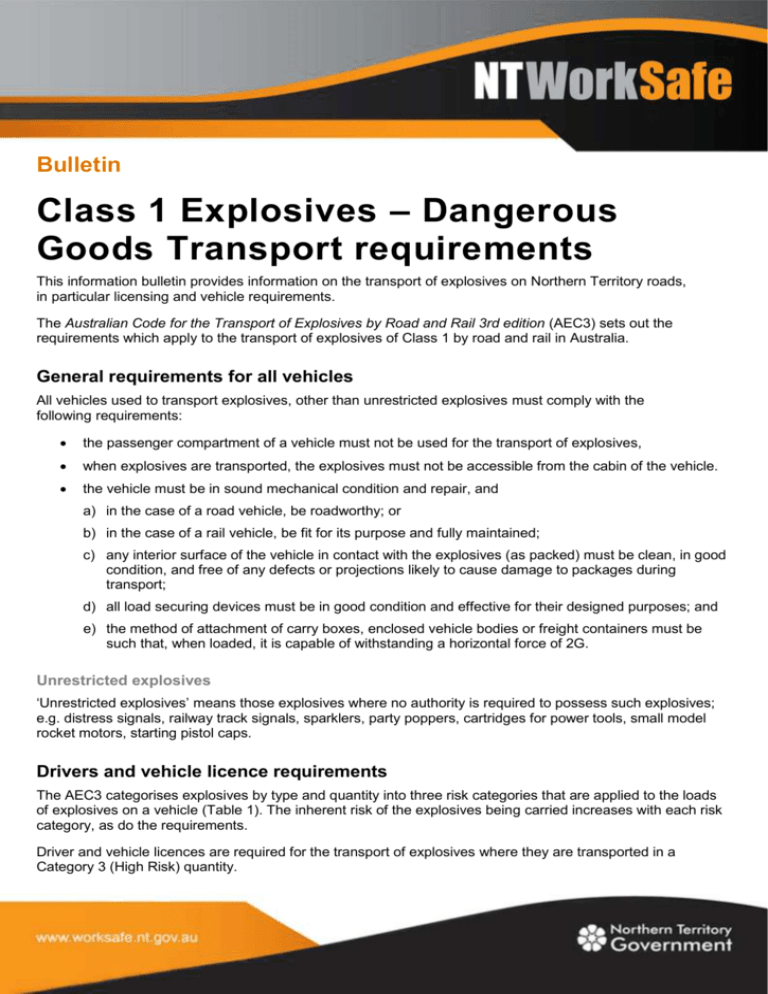
Bulletin Class 1 Explosives – Dangerous Goods Transport requirements This information bulletin provides information on the transport of explosives on Northern Territory roads, in particular licensing and vehicle requirements. The Australian Code for the Transport of Explosives by Road and Rail 3rd edition (AEC3) sets out the requirements which apply to the transport of explosives of Class 1 by road and rail in Australia. General requirements for all vehicles All vehicles used to transport explosives, other than unrestricted explosives must comply with the following requirements: the passenger compartment of a vehicle must not be used for the transport of explosives, when explosives are transported, the explosives must not be accessible from the cabin of the vehicle. the vehicle must be in sound mechanical condition and repair, and a) in the case of a road vehicle, be roadworthy; or b) in the case of a rail vehicle, be fit for its purpose and fully maintained; c) any interior surface of the vehicle in contact with the explosives (as packed) must be clean, in good condition, and free of any defects or projections likely to cause damage to packages during transport; d) all load securing devices must be in good condition and effective for their designed purposes; and e) the method of attachment of carry boxes, enclosed vehicle bodies or freight containers must be such that, when loaded, it is capable of withstanding a horizontal force of 2G. Unrestricted explosives ‘Unrestricted explosives’ means those explosives where no authority is required to possess such explosives; e.g. distress signals, railway track signals, sparklers, party poppers, cartridges for power tools, small model rocket motors, starting pistol caps. Drivers and vehicle licence requirements The AEC3 categorises explosives by type and quantity into three risk categories that are applied to the loads of explosives on a vehicle (Table 1). The inherent risk of the explosives being carried increases with each risk category, as do the requirements. Driver and vehicle licences are required for the transport of explosives where they are transported in a Category 3 (High Risk) quantity. Table 1 – Risk Categories for Explosives Please see Notes below for explanation of the bracketed numbers in the table. Type of Explosives (2) Quantity per Vehicle (1) Division Category 1 (Low Risk) Division 1.1 A (3) Transport must be specifically approved by the Competent Authority Detonators of 1.1B ≤125 items >125–5000 items >5000 items All other Division 1.1 ≤5kg >5–250kg >250kg Division 1.2 ≤5kg >5–250kg >250kg Division 1.3 ≤50kg >50–1000kg >1000kg Detonators of 1.4B or 1.4S ≤125 items >125 items n/a (5) All other Division 1.4 ≤250kg >250kg n/a (5) All other Division 1.4 S (other than Detonators) Any quantity n/a (5) n/a (5) Division 1.5 ≤25kg >25-250kg (4) >250kg (4) Division 1.6 ≤25kg >25kg n/a (5) Category 2 (Moderate Risk) Category 3 (High Risk) Caption: Table 1 - Risk Categories for Explosives Notes: 1) Quantity in NEQ, except where otherwise specified. 2) For mixed loads, the Division and Compatibility Group for the entire load shall be determined as outlined in Section 7.3.2, prior to assigning the appropriate Risk Category to that load. 3) Transport of explosives of Classification Code 1.1A is to be specifically approved by the Competent Authority. 4) This applies only for the purposes of Section 8.4, quantities of explosives of Division 1.5 greater than 250kg are considered to be Category 3. 5) “n/a”– means not applicable. 6) For transport of Class 5 .1 with Class 1 refer to Sections 2.4(3) and 2.4(4) to determine the risk category. Additional information AEC3 Australian Code for the Transport of Explosives by Road and Rail 3rd edition (AEC3) can be downloaded at no cost from the Safe Work Australia website www.safeworkaustralia.gov.au Contact us For further information please contact us on 1800 019 115, facsimile (08) 8999 5141, via email at ntworksafe@nt.gov.au or go to the NT WorkSafe website at www.worksafe.nt.gov.au 2 Class 1 Explosives – Dangerous Goods Transport requirements (V1.2 – 3 February 2015)

